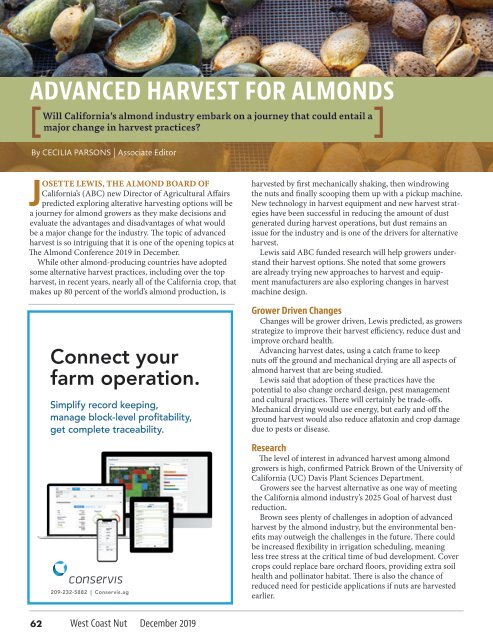WCN December 2019
Create successful ePaper yourself
Turn your PDF publications into a flip-book with our unique Google optimized e-Paper software.
ADVANCED HARVEST FOR ALMONDS<br />
Will California’s almond industry embark on a journey that could entail a<br />
major change in harvest practices?<br />
By CECILIA PARSONS | Associate Editor<br />
JOSETTE LEWIS, THE ALMOND BOARD OF<br />
California’s (ABC) new Director of Agricultural Affairs<br />
predicted exploring alterative harvesting options will be<br />
a journey for almond growers as they make decisions and<br />
evaluate the advantages and disadvantages of what would<br />
be a major change for the industry. The topic of advanced<br />
harvest is so intriguing that it is one of the opening topics at<br />
The Almond Conference <strong>2019</strong> in <strong>December</strong>.<br />
While other almond-producing countries have adopted<br />
some alternative harvest practices, including over the top<br />
harvest, in recent years, nearly all of the California crop, that<br />
makes up 80 percent of the world’s almond production, is<br />
Connect your<br />
farm operation.<br />
Simplify record keeping,<br />
manage block-level profitability,<br />
get complete traceability.<br />
209-232-5882 | Conservis.ag<br />
harvested by first mechanically shaking, then windrowing<br />
the nuts and finally scooping them up with a pickup machine.<br />
New technology in harvest equipment and new harvest strategies<br />
have been successful in reducing the amount of dust<br />
generated during harvest operations, but dust remains an<br />
issue for the industry and is one of the drivers for alternative<br />
harvest.<br />
Lewis said ABC funded research will help growers understand<br />
their harvest options. She noted that some growers<br />
are already trying new approaches to harvest and equipment<br />
manufacturers are also exploring changes in harvest<br />
machine design.<br />
Grower Driven Changes<br />
Changes will be grower driven, Lewis predicted, as growers<br />
strategize to improve their harvest efficiency, reduce dust and<br />
improve orchard health.<br />
Advancing harvest dates, using a catch frame to keep<br />
nuts off the ground and mechanical drying are all aspects of<br />
almond harvest that are being studied.<br />
Lewis said that adoption of these practices have the<br />
potential to also change orchard design, pest management<br />
and cultural practices. There will certainly be trade-offs.<br />
Mechanical drying would use energy, but early and off the<br />
ground harvest would also reduce aflatoxin and crop damage<br />
due to pests or disease.<br />
Research<br />
The level of interest in advanced harvest among almond<br />
growers is high, confirmed Patrick Brown of the University of<br />
California (UC) Davis Plant Sciences Department.<br />
Growers see the harvest alternative as one way of meeting<br />
the California almond industry’s 2025 Goal of harvest dust<br />
reduction.<br />
Brown sees plenty of challenges in adoption of advanced<br />
harvest by the almond industry, but the environmental benefits<br />
may outweigh the challenges in the future. There could<br />
be increased flexibility in irrigation scheduling, meaning<br />
less tree stress at the critical time of bud development. Cover<br />
crops could replace bare orchard floors, providing extra soil<br />
health and pollinator habitat. There is also the chance of<br />
reduced need for pesticide applications if nuts are harvested<br />
earlier.<br />
62<br />
West Coast Nut <strong>December</strong> <strong>2019</strong>


















